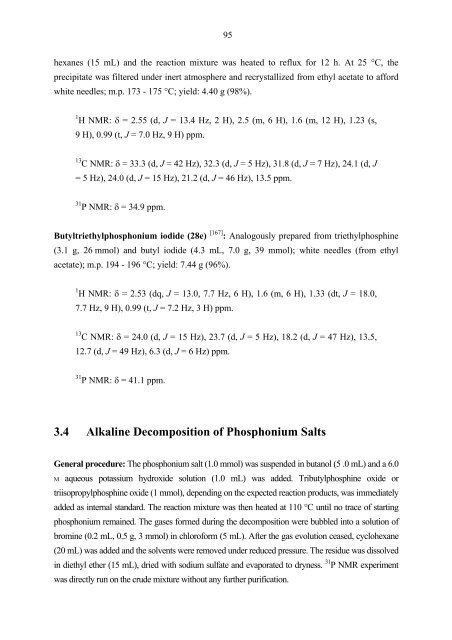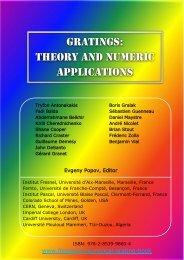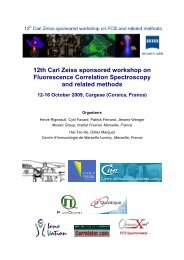My PhD dissertation - Institut Fresnel
My PhD dissertation - Institut Fresnel
My PhD dissertation - Institut Fresnel
Create successful ePaper yourself
Turn your PDF publications into a flip-book with our unique Google optimized e-Paper software.
95<br />
hexanes (15 mL) and the reaction mixture was heated to reflux for 12 h. At 25 °C, the<br />
precipitate was filtered under inert atmosphere and recrystallized from ethyl acetate to afford<br />
white needles; m.p. 173 - 175 °C; yield: 4.40 g (98%).<br />
1 H NMR: δ = 2.55 (d, J = 13.4 Hz, 2 H), 2.5 (m, 6 H), 1.6 (m, 12 H), 1.23 (s,<br />
9 H), 0.99 (t, J = 7.0 Hz, 9 H) ppm.<br />
13 C NMR: δ = 33.3 (d, J = 42 Hz), 32.3 (d, J = 5 Hz), 31.8 (d, J = 7 Hz), 24.1 (d, J<br />
= 5 Hz), 24.0 (d, J = 15 Hz), 21.2 (d, J = 46 Hz), 13.5 ppm.<br />
31 P NMR: δ = 34.9 ppm.<br />
Butyltriethylphosphonium iodide (28e) [167] : Analogously prepared from triethylphosphine<br />
(3.1 g, 26 mmol) and butyl iodide (4.3 mL, 7.0 g, 39 mmol); white needles (from ethyl<br />
acetate); m.p. 194 - 196 °C; yield: 7.44 g (96%).<br />
1 H NMR: δ = 2.53 (dq, J = 13.0, 7.7 Hz, 6 H), 1.6 (m, 6 H), 1.33 (dt, J = 18.0,<br />
7.7 Hz, 9 H), 0.99 (t, J = 7.2 Hz, 3 H) ppm.<br />
13 C NMR: δ = 24.0 (d, J = 15 Hz), 23.7 (d, J = 5 Hz), 18.2 (d, J = 47 Hz), 13.5,<br />
12.7 (d, J = 49 Hz), 6.3 (d, J = 6 Hz) ppm.<br />
31 P NMR: δ = 41.1 ppm.<br />
3.4 Alkaline Decomposition of Phosphonium Salts<br />
General procedure: The phosphonium salt (1.0 mmol) was suspended in butanol (5 .0 mL) and a 6.0<br />
M aqueous potassium hydroxide solution (1.0 mL) was added. Tributylphosphine oxide or<br />
triisopropylphosphine oxide (1 mmol), depending on the expected reaction products, was immediately<br />
added as internal standard. The reaction mixture was then heated at 110 °C until no trace of starting<br />
phosphonium remained. The gases formed during the decomposition were bubbled into a solution of<br />
bromine (0.2 mL, 0.5 g, 3 mmol) in chloroform (5 mL). After the gas evolution ceased, cyclohexane<br />
(20 mL) was added and the solvents were removed under reduced pressure. The residue was dissolved<br />
in diethyl ether (15 mL), dried with sodium sulfate and evaporated to dryness. 31 P NMR experiment<br />
was directly run on the crude mixture without any further purification.













